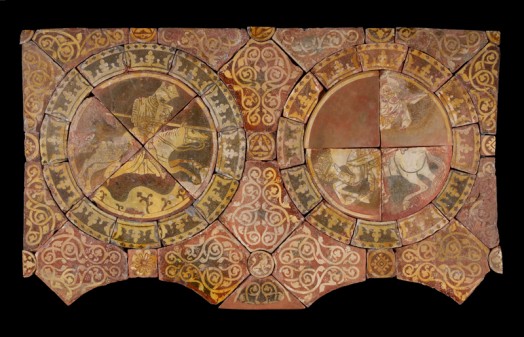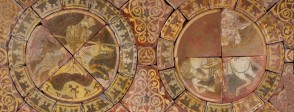
The tiles
These tiles were found at the Benedictine abbey of Chertsey in Surrey. They were discovered accidentally in 1852 by the owner of the site, Samuel Grumbridge, when he uncovered fragments of a large tiled floor. The tiles depict a combat between Richard I and the Muslim leader Saladin. Richard and Saladin never actually encountered each other face to face, although their armies clashed several times during the course of the Third Crusade. However, since the end of the AD 1100s, the Third Crusade had been represented as a personal duel between the two leaders. By the later middle ages, manuscript images, wall paintings and tiles like those from Chertsey had helped fixed the image of Richard and Saladin locked in single combat in popular memory.
Other tiles from Chertsey portray scenes from the story of Tristan and Isolde, which was the subject of one of the most famous popular prose romances of the AD 1200s. We know that Richard also featured as the hero of a romance in this period, so it is quite possible that the tiles were a literary reference. Fragments found close to the Richard and Saladin tiles contained letters spelling Richard’s name and other words, suggesting that an inscription surrounded them.
The Third Crusade (1187 – 1192)
In July 1187, Saladin’s forces defeated the armies of the crusader states at the Battle of Hattin. By the end of September 1187, Saladin had achieved his goal: the recapture of Jerusalem. For the first time in nearly ninety years the Muslims were in control of the Holy City. It was the shock of Saladin’s victories at Hattin and Jerusalem that prompted the Third Crusade.
The crusade was led by the three most powerful monarchs in the Latin West: Richard I of England, Philip II of France and Frederick I of Germany. This potentially gave the crusade enormous strength, but things did not go well for the crusaders. Frederick and his armies travelled on an overland route to the Holy Land; in June 1190, the German king drowned while crossing a river. By the time Richard and Philip reached the crusader port of Acre in June 1191, a deep mistrust had developed between the two kings. They defeated Saladin’s forces at Acre, but Philip decided to abandon the crusade and returned to France. It was left to Richard to attempt the re-conquest of Jerusalem.
Following a long and gruelling march in the summer heat of 1191, Richard’s forces defeated Saladin at the Battle of Arsuf on 7 September. The way to Jerusalem was now open. Richard made his first attempt to take Jerusalem during the winter of 1191 – 2, but the king doubted that his forces would be able to sustain a siege of the city and he abandoned the attack. The following summer he made a second attempt to take Jerusalem. Once again, Richard decided that the lack of water, the difficulty of supplying the army and Jerusalem’s formidable defences made a successful attack unlikely. On 4 July 1192, the Third Crusade collapsed. In September, the crusaders and Muslims signed a truce. Richard I refused to visit Jerusalem and therefore never met Saladin. Following the stalemate of the Third Crusade in 1192, the Christian West sent a number of crusades to Palestine, Syria and Egypt. All ended in failure. By 1291, with the fall of the crusader city of Acre, the Muslims’ victory was complete.
Not all conflict
The image on the Chertsey tiles is violent and shocking. This killing of Saladin by Richard I might be imagined, but it cannot be denied that the era of the crusades was characterised by periods of terrible conflict between Christians and Muslims. This is, however, only part of the story. During the 12th and 13th centuries there were long periods of peace. Trade flourished, ideas were exchanged, and artistic styles were copied and fused. Some historians have argued that a distinctive Crusader Art emerged which combined Western, Byzantine and Islamic elements. The peaceful exchange of knowledge, ideas and artistic styles continued into the later middle ages.
More information
The Richard and Saladin tiles
http://www.britishmuseum.org/explore/highlights/highlight_objects/pe_mla/c/chertsey_tiles.aspx
A Tristan tile from Chertsey
http://medievalromance.bodleian.ox.ac.uk/A_Tristan_tile_from_Chertsey_Abbey
Richard I’s reign
An overview Richard I’s reign and his involvement in the Third Crusade.
http://www.bbc.co.uk/history/historic_figures/richard_i_king.shtml
In Our Time from BBC Radio 4
Melvin Bragg and guests discuss the Third Crusade in 2001.
http://www.bbc.co.uk/programmes/p00547ls
The Long View from BBC Radio 4
The Crusades.
http://www.bbc.co.uk/radio4/history/longview/longview_20021029.shtml
Interview with Thomas Asbridge
Interview with Thomas Asbridge about his book The Crusades (2010).
https://www.youtube.com/watch?v=Q1ZrloO7o-A
A medieval source
The capture of the Holy Land by Saladin.
http://www.fordham.edu/halsall/source/1187saladin.asp
Crusader art
A famous example of crusader art: The Melisende Psalter.
http://www.bl.uk/onlinegallery/sacredtexts/melispsalter.html
BBC History of the wolrd in 100 objects
Useful information about trading contacts between European and Islamic worlds.
http://www.bbc.co.uk/ahistoryoftheworld/objects/2GL6QSA8SMmcMCtPgHQJsw
Article on the Crusades
Article on the Crusades in later western culture.
http://www.library.rochester.edu/robbins/crusades
More information
-
The Richard and Saladin tiles
Source: britishmuseum.org
-
A Tristan tile from Chertsey
Source: medievalromance.bodleian.ox.ac.uk
-
Richard I’s reign
An overview Richard I’s reign and his involvement in the Third Crusade.
Source: bbc.co.uk
-
In Our Time from BBC Radio 4
Melvin Bragg and guests discuss the Third Crusade in 2001.
Source: bbc.co.uk
-
The Long View from BBC Radio 4
The Crusades.
Source: bbc.co.uk
-
Interview with Thomas Asbridge
Interview with Thomas Asbridge about his book The Crusades (2010).
Source: youtube.com
-
A medieval source
The capture of the Holy Land by Saladin.
Source: fordham.edu
-
Crusader art
A famous example of crusader art: The Melisende Psalter.
Source: bl.uk
-
BBC History of the wolrd in 100 objects
Useful information about trading contacts between European and Islamic worlds.
Source: bbc.co.uk
-
Article on the Crusades
Article on the Crusades in later western culture.
Source: library.rochester.edu


